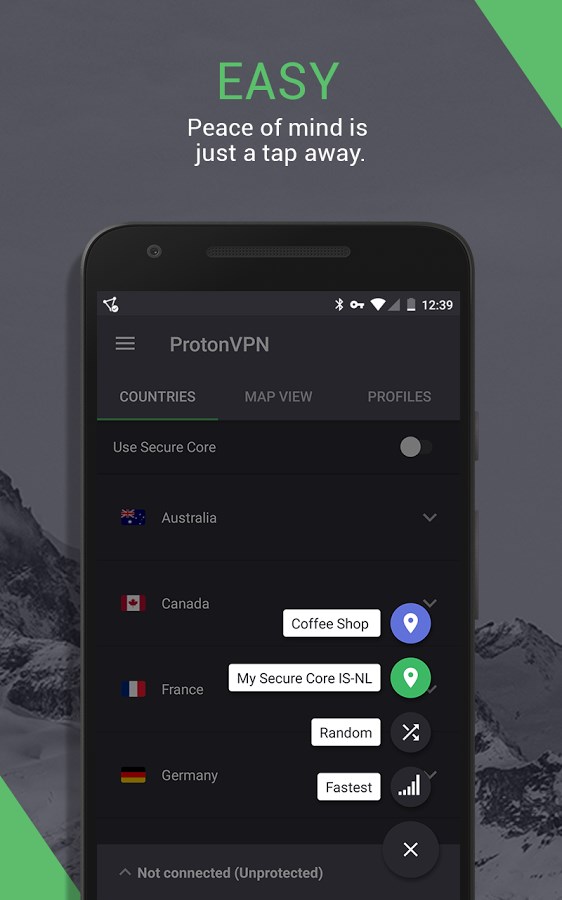

- #Protonvpn android install#
- #Protonvpn android full#
- #Protonvpn android windows 10#
- #Protonvpn android pro#
- #Protonvpn android code#
Deep packet inspection would still block the traffic I assume, but in all cases with regular public hotspots in my country I have been able to connect to my VPN after I made this change of what port I am using. This has allowed me to connect to my VPN even when using some public hotspots that were very restrictive on what traffic they allowed through and where previously I could not connect to my WireGuard VPN. Some months ago I changed the WireGuard configuration on my server to run on port 443 UDP instead of the UDP port that WireGuard server would run on by default. WireGuard has been very stable and reliable too for all of the time that I have been using it.

And I am sure it is equally simple to set up on many other systems as well. WireGuard has been almost trivially simple to set up across all of these systems FreeBSD, macOS, iOS, Linux.

WireGuard client running on my desktop computer which runs KDE Neon Linux. I also have the builtin SSH server running on his computer that I connect to over WG VPN to transfer files or run commands through. In either case the connection is tunneled over the WireGuard VPN. I use the macOS-builtin VNC client on my MBP or a third-party VNC client on my iPhone. This allows me to remote into his computer via the macOS-builtin VNC server on his computer, to help him out when he is stuck at something.
#Protonvpn android pro#
WireGuard client running on my grandfather's Mac Pro desktop computer. Like with my laptop, I activate it when I need to connect to the server or to another device on the VPN. WireGuard client running on my iPhone X. I activate this one when I need to connect to my server or to some other device on the VPN. WireGuard client running on my MacBook Pro M1 laptop (and prior to that, on the MacBook Air that I had before this computer). WireGuard server running on my FreeBSD VPS. I've been running a WireGuard setup for a couple of years now, and have been and continue to be very satisfied with it. Wireguard is at least 10 times tougher than that, even if it worked, which it currently does not. ovpn file, import it into whatever client devices I need, and it works.
#Protonvpn android install#
For OpenVPN I run an apt install command, run a wizard, SFTP into the box, transfer out the. Someone just come out with a wizard/package installer that actually works reasonably well (like OpenVPN has already) and then it might be "easy" to install.
#Protonvpn android windows 10#
I've helped administer OpenVPN servers for a decade now (and take no pride in it), and yet all these errors that keep coming up in Wireguard configuration for me on a main Linux distro + Windows 10 client seem pretty odd for something that's supposedly so easy to use.
#Protonvpn android full#
Like I said, everyone keeps saying Wireguard is dead simple to set up, but the comments are full of editing configuration files, priv/pub key pairs, etc. PostDown = iptables -D FORWARD -i %i -j ACCEPT iptables -t nat -D POSTROUTING -o eth0 -j MASQUERADE iptables -D FORWARD -o %i -j ACCEPT PostUp = iptables -A FORWARD -i %i -j ACCEPT iptables -t nat -A POSTROUTING -o eth0 -j MASQUERADE iptables -A FORWARD -o %i -j ACCEPT
#Protonvpn android code#
All in all, it was like 10 mins of fiddling in some testing VMs and a bit of googling, and then a couple of more minutes to apply what iIlearned and set up the real "prod".Īlready reads as such, though I've tried that code snippet too: But once I had two peers in my wireguard setup up and running (the "server" and the first client) adding more clients was a breeze compared to doing the same in OpenVPN. Setting up a "server" is always more intricate be it OpenVPN be it wireguard, tho. The point-to-point stuff worked immediately tho without having to sprinkle any magic pixie dust on top first. Wireguard just worked for me, except I first forgot to enable port forwarding / the NAT stuff on the interface on the "server" peer so that I could route all traffic through it (other people already remarked about that), not just have a point-to-point to it. And then again some more work because client certs expired, and again more work because the distro changed some things and required a different config suddenly (not really OpenVPN's fault) to get a ca+client certs for auth set up, find a config that works for each OS where I have clients, etc. OpenVPN required a lot more fiddling e.g. First OpenVPN because that's what I used before wireguard was around (and now keep as a fallback that I never use). I have both OpenVPN and wireguard set up, running my own server/"server" peer.


 0 kommentar(er)
0 kommentar(er)
